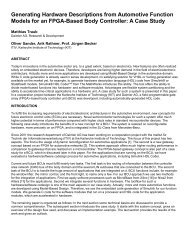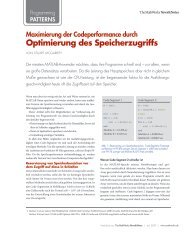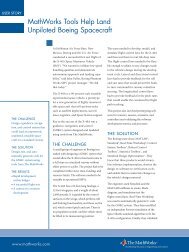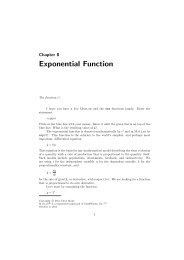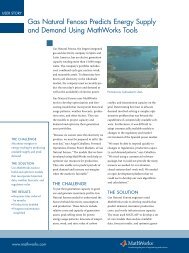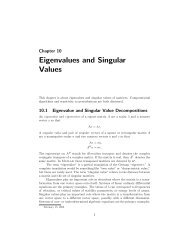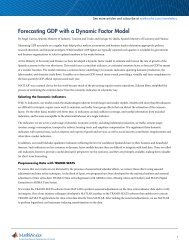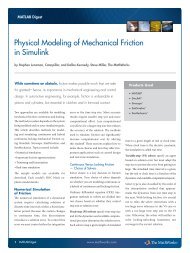Chapter 6. Quadrature - MathWorks
Chapter 6. Quadrature - MathWorks
Chapter 6. Quadrature - MathWorks
You also want an ePaper? Increase the reach of your titles
YUMPU automatically turns print PDFs into web optimized ePapers that Google loves.
<strong>6.</strong>7. Further Reading 13<br />
The quantity D is a higher order correction to the trapezoid rule that makes use of<br />
the slopes computed by splinetx or pchiptx.<br />
If the x’s are equally spaced, most of the terms in the sum cancel each other.<br />
Then D becomes a simple end correction involving just the first and last slopes:<br />
D = h 2 dn − d1<br />
.<br />
12<br />
For the sample data shown in Figure <strong>6.</strong>4, the area obtained by linear interpolation<br />
is 35.00 and by spline interpolation is 35.25. We haven’t shown shape-preserving<br />
Hermite interpolation, but its area is 35.41667. The integration process averages<br />
out the variation in the interpolants, so even though the three graphs might have<br />
rather different shapes, the resulting approximations to the integral are often quite<br />
close to each other.<br />
<strong>6.</strong>7 Further Reading<br />
For background on quad and quadl, see Gander and Gautschi [3].<br />
Exercises<br />
<strong>6.</strong>1. Use quadgui to try to find the integrals of each of the following functions<br />
over the given interval and with the given tolerance. How many function<br />
evaluations are required for each problem and where are the evaluation points<br />
concentrated?<br />
f(x) a b tol<br />
humps(x) 0 1 10 −4<br />
humps(x) 0 1 10 −6<br />
humps(x) −1 2 10 −4<br />
sin x 0 π 10 −8<br />
cos x 0 (9/2)π 10 −6<br />
√ x 0 1 10 −8<br />
√ x log x eps 1 10 −8<br />
tan(sin x) − sin(tan x) 0 π 10 −8<br />
1/(3x − 1) 0 1 10 −4<br />
t 8/3 (1 − t) 10/3 0 1 10 −8<br />
t 25 (1 − t) 2 0 1 10 −8<br />
<strong>6.</strong>2. Express Q as a weighted combination of the five function values f(a) through<br />
f(e) and establish that its order is six. (See section <strong>6.</strong>2.)<br />
<strong>6.</strong>3. The composite trapezoid rule with n equally spaced points is<br />
Tn(f ) = h<br />
2<br />
n−2 <br />
f(a) + h<br />
k=1<br />
f(a + kh) + h<br />
2 f(b),







